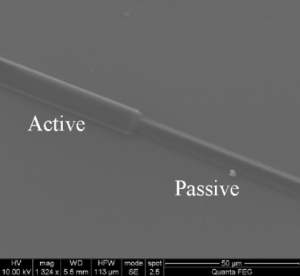Aug 24 2010
Photonic integrated circuits (PICs), in which photons carry out signal processing, are expected to play a crucial role in next-generation computing and communication systems. Much progress has been made over the last decade toward realizing all-optical circuits on a chip.
The major hindrances are integrating active and passive photonic components, integrating photonic devices with silicon electronics, and the large footprint of PICs. The first two issues have been addressed using techniques such as regrowth, wafer fusion, and asymmetric twin-guide technology. To address the large footprint, researchers have moved to a silicon-on-insulator process whose large refractive-index contrast enables realization of compact waveguides and waveguide bends. More recently, plasmonic waveguides have also been explored to circumvent the diffraction limit.
 Scanning-electron-microscope image of an active waveguide consisting of a quantum-dot-embedded SU-8 photoresist (Microchem Inc.) integrated with a passive waveguide.
Scanning-electron-microscope image of an active waveguide consisting of a quantum-dot-embedded SU-8 photoresist (Microchem Inc.) integrated with a passive waveguide.
Yet another challenge in achieving low-energy, all-optical processors is the weak optical nonlinearity of semiconductors. Quantum dots have been touted as an attractive alternative in this context because of their large optical nonlinearities. Most quantum-dot-based photonic systems realized to date have used dots grown using molecular-beam epitaxy. More recently, colloidal quantum dots synthesized using simple chemistry have received much attention because of their low cost of production, wide range of accessible wavelengths, compatibility with silicon technology, and high quantum yield, especially for applications in bioimaging, LEDs, and solar cells. Here we report a solution-processed, mechanically flexible vertical-cavity surface-emitting laser (VCSEL) and planar photonic devices using colloidal quantum dots as the active medium.6
In a different demonstration, we realized vertically integrated, 3D photonic circuits using a bottom-up approach. This differs considerably from the top-down approach that is widely employed in traditional semiconductor-based PICs. Use of colloidal quantum dots in a polymer host matrix as the active medium for emission, amplification, and detection has the advantage of compatibility with silicon technology and coverage of a wide spectral range. All circuits currently being pursued are fabricated on a silicon-on-insulator substrate. Employing silicon for passive structures, such as waveguides, resonators, and couplers, has the additional benefit of enabling smaller-footprint devices. Figure shows a scanning-electron-microscope image of one such device built using electron-beam lithography that incorporates a passive waveguide integrated with an active waveguide.
One of the key issues in constructing planar photonic circuits is the effect of the polymer host matrix on the optical properties of the quantum dots. Results of steady-state and time-resolved luminescence measurements indicate that poly(methyl methacrylate) is a good host with minimal detrimental effects.
The work described here indicates a potentially new area of application for colloidal quantum dots. The combination of materials research for identifying suitable host matrices and of simpler fabrication techniques, such as soft lithography, makes it possible to realize low-cost PICs, potentially even on flexible substrates. Future plans include electrically pumped versions of the VCSEL, single-photon sources, planar microresonators, and active photonic crystals using colloidal quantum-dot composites.
Source: http://spie.org/